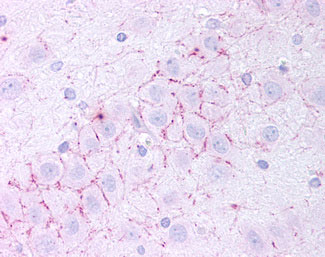TAAR5 Antibody (N-Terminus)
Rabbit Polyclonal Antibody
- SPECIFICATION
- CITATIONS
- PROTOCOLS
- BACKGROUND

Application
| IHC-P, E |
|---|---|
| Primary Accession | O14804 |
| Reactivity | Human, Rabbit |
| Host | Rabbit |
| Clonality | Polyclonal |
| Calculated MW | 38kDa |
| Dilution | IHC-P (20 µg/ml) |
| Gene ID | 9038 |
|---|---|
| Other Names | Trace amine-associated receptor 5, TaR-5, Trace amine receptor 5, hTaar5, Putative neurotransmitter receptor, TAAR5, PNR |
| Target/Specificity | Human TAAR5. BLAST analysis of the peptide immunogen showed no homology with other human proteins. |
| Reconstitution & Storage | Long term: -70°C; Short term: +4°C |
| Precautions | TAAR5 Antibody (N-Terminus) is for research use only and not for use in diagnostic or therapeutic procedures. |
| Name | TAAR5 {ECO:0000303|PubMed:15718104, ECO:0000312|HGNC:HGNC:30236} |
|---|---|
| Function | Olfactory receptor specific for trimethylamine, a trace amine (PubMed:23393561). Also activated at lower level by dimethylethylamine (PubMed:23393561). Trimethylamine is a bacterial metabolite found in some animal odors, and to humans it is a repulsive odor associated with bad breath and spoiled food (PubMed:23393561). Trimethylamine-binding causes a conformation change that triggers signaling via G(s)-class of G alpha proteins (GNAL or GNAS) (PubMed:23393561). |
| Cellular Location | Cell membrane; Multi-pass membrane protein |
| Tissue Location | Expressed almost exclusively in skeletal muscle and selected areas of the brain, such amygdala, hippocampus, caudate nucleus, thalamus and hypothalamus (PubMed:9464258). Weak expression is also find in substantia nigra (PubMed:9464258) |
| Volume | 50 µl |

Thousands of laboratories across the world have published research that depended on the performance of antibodies from Abcepta to advance their research. Check out links to articles that cite our products in major peer-reviewed journals, organized by research category.
info@abcepta.com, and receive a free "I Love Antibodies" mug.
Provided below are standard protocols that you may find useful for product applications.
Background
Olfactory receptor specific for trimethylamine, a trace amine. Also activated at lower level by dimethylethylamine. Trimethylamine is a bacterial metabolite found in some animal odors, and to humans it is a repulsive odor associated with bad breath and spoiled food. This receptor is probably mediated by the G(s)-class of G-proteins which activate adenylate cyclase.
References
Zeng Z.,et al.Biochem. Biophys. Res. Commun. 242:575-578(1998).
Lindemann L.,et al.Genomics 85:372-385(2005).
Staubert C.,et al.PLoS ONE 5:E11133-E11133(2010).
Mungall A.J.,et al.Nature 425:805-811(2003).
Mural R.J.,et al.Submitted (SEP-2005) to the EMBL/GenBank/DDBJ databases.
If you have used an Abcepta product and would like to share how it has performed, please click on the "Submit Review" button and provide the requested information. Our staff will examine and post your review and contact you if needed.
If you have any additional inquiries please email technical services at tech@abcepta.com.













 Foundational characteristics of cancer include proliferation, angiogenesis, migration, evasion of apoptosis, and cellular immortality. Find key markers for these cellular processes and antibodies to detect them.
Foundational characteristics of cancer include proliferation, angiogenesis, migration, evasion of apoptosis, and cellular immortality. Find key markers for these cellular processes and antibodies to detect them. The SUMOplot™ Analysis Program predicts and scores sumoylation sites in your protein. SUMOylation is a post-translational modification involved in various cellular processes, such as nuclear-cytosolic transport, transcriptional regulation, apoptosis, protein stability, response to stress, and progression through the cell cycle.
The SUMOplot™ Analysis Program predicts and scores sumoylation sites in your protein. SUMOylation is a post-translational modification involved in various cellular processes, such as nuclear-cytosolic transport, transcriptional regulation, apoptosis, protein stability, response to stress, and progression through the cell cycle. The Autophagy Receptor Motif Plotter predicts and scores autophagy receptor binding sites in your protein. Identifying proteins connected to this pathway is critical to understanding the role of autophagy in physiological as well as pathological processes such as development, differentiation, neurodegenerative diseases, stress, infection, and cancer.
The Autophagy Receptor Motif Plotter predicts and scores autophagy receptor binding sites in your protein. Identifying proteins connected to this pathway is critical to understanding the role of autophagy in physiological as well as pathological processes such as development, differentiation, neurodegenerative diseases, stress, infection, and cancer.


